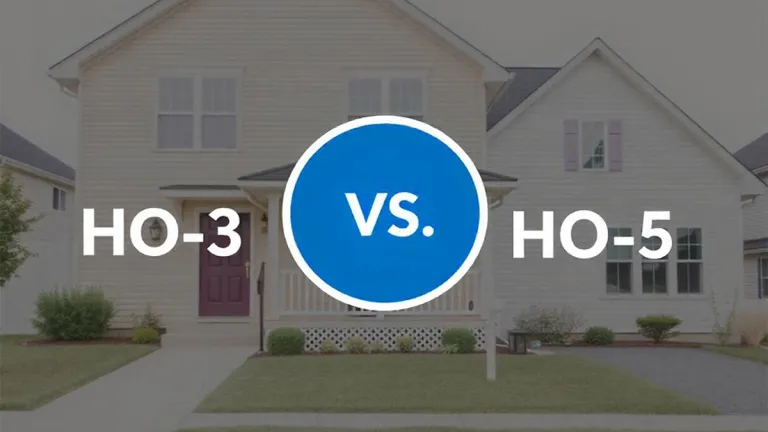
When you want to purchase home insurance, HO-3 and HO-5 are common terms you will hear. These two common types of homeowner insurance policies provide financial protection in case of damage to your home, your personal belongings, or other structures in your property, as well as other damages to other people’s property that you are responsible for.
However, you need to know that although HO-3 and HO-5 are very similar, they offer different coverage and vary in cost. Before buying home insurance, it is advisable to know the differences between HO-3 vs. HO-5 Home Insurance. This will help you make a good decision when choosing the right policy for your home.
What Does Home Insurance Cover?
The best home insurance offers protection against common homeowner issues, like house damage or theft. Below is a quick breakdown of typical coverage:
- Dwelling Insurance: Pays to repair your house and attached structures. For example, garage, porch.
- Other Structures: Covers unattached property like a gazebo, pool house, or shed.
- Personal Property Insurance: Pays if items inside your home are damaged or stolen.
- Personal Liability Insurance: This coverage helps in covering costs of your responsibilities financially if you accidentally damage someone’s property or are legally liable for injuring someone (this does not include auto accidents).
- Medical Payments Insurance: Pays small medical bills if a guest is hurt in your home, regardless of who is at fault.
- Loss of Use Insurance: This can also be referred to as additional living expenses coverage. The coverage helps pay for temporary meals, laundry, and other essential services while your home is being repaired after an event that is covered by the policy.
What is HO-3 Insurance?
Also referred to as a special form policy, HO-3 is the most common and popular type of home insurance. Just so you know, it’s more comprehensive than HO-1 and HO-2 policies. But offers little coverage than HO-5 policies, making it more affordable than HO-5.
What Does HO-3 Insurance Cover?
This coverage covers your dwelling, other structures on your property, medical payments, personal property, and loss of use.
Key Features of HO-3 Insurance
- Open perils coverage for dwelling and structures: Pays for any damage unless specifically excluded (e.g., floods).
- Named perils coverage for personal items: Only covers specific issues listed in the policy (e.g., fire).
HO-3 offers coverage for your personal possessions/belongings for these covered 16 named perils;
- Accidental cracking, tearing of heating, burning, or plumbing, AC, or sprinkler systems
- Accidental damage from electrical shortcircuits
- Damage from cars
- Damage from planes
- Explosions
- Falling objects
- Fire or lightning
- Hail and windstorms
- Damage from ice, snow, or sleet
- Damage from frozen pipes
- Lightning strikes
- Riots and civil disturbances
- Smoke damage
- Sudden water overflow
- Theft
- Unexpected electrical malfunctions and power surges
- and Vandalism
Keep in mind that if you don’t have replacement cost coverage for your belongings, this policy reimburses based on actual cash value. Actual cash value factors in wear and tear or depreciation when the insurer pays out for your loss.
This is totally different from the replacement cost value that doesn’t factor in depreciation. With RCV, you will be paid for the expenses to purchase new, similar items to replace the old, damaged items.
What Does HO-3 Not Cover?
This policy won’t cover all types of damages or events. The below are the exclusions you will see in this policy:
- Ordinance or law.
- Earth movement. For example, landslides, earthquakes, and mudslides.
- Certain water damage like storms and floods
- Power failure.
- Neglect
- War
- Nuclear hazards.
- Intentional damage
- Governmental action
What Is HO-5 Insurance?
HO-5 insurance provides more comprehensive protection than other home insurance types. Known as a comprehensive policy, it offers coverage for your home, unattached structures, and personal belongings on an “open perils” basis. This typically means it covers any damage unless they are specifically excluded in the policy.
What HO-5 Insurance Covers
- Dwelling and Detached Structures: Covers the main house and any unattached buildings.
- Personal Property: Includes all your belongings, paid out based on replacement cost.
- Medical Payments to Others: Covers medical expenses for injuries on your property.
- Personal Liability: Protect policyholders against lawsuits for bodily injury or property damage.
- Loss of Use: paying for additional living bills if you can’t live in your home due to a covered damage.
Exclusions
- HO-5 policies exclude certain types of damage, similar to HO-3 policies.
Generally speaking, HO-5 insurance offers broad coverage with reimbursements based on the replacement cost of your items, except for specifically excluded
Named Perils vs. Open Perils
Understanding the difference between named perils and open perils is very important when comparing homeowners insurance.
Named Perils Coverage:
- Covers damage from specific causes listed in the policy.
- Typically includes 16 named perils such as fire, smoke damage, theft, vandalism, and hail.
- If a problem isn’t named in the policy, it’s not covered.
Open Perils Coverage:
- Covers any problem unless explicitly excluded in the policy.
- Provides broader coverage compared to named perils policies.
In literal terms, named perils cover specific risks. Meanwhile, open perils offer more comprehensive and broad protection by covering everything except listed exclusions.
Actual Cash Value (ACV) vs. Replacement Cost Value (RCV)
These terms define how you’re compensated for a personal property claim.
ACV:
- Reflects the current value of your belongings after depreciation.
- Example: If a fire destroys your living room, your furniture, decor, and TV, which would cost $20,000 to replace new, might only get you $10,000 due to depreciation.
RCV:
- Pays the amount needed to replace your belongings with new, similar items.
- Example: For the same fire damage, an RCV policy would cover the full $20,000 to replace your items (minus your deductible), as it doesn’t account for depreciation.
ACV policies are cheaper but offer less coverage because they factor in depreciation. RCV policies, on the other hand, cost more but provide higher payouts for claim
HO-3 vs. HO-5 Home Insurance: What’s the Difference?
The key difference between HO-3 and HO-5 home insurance is that one provides better protection for your personal belongings than the other. HO-3 covers your home possession only for certain events named in the policy, like wind and fire. And are very common between new homebuyers.
Meanwhile, an HO5 policy helps in insuring your personal belongings against all damages or events that are not excluded in the policy. And are usually used to insure very expensive homes.
Another difference we should look at is that, automatically, HO-5 includes replacement cost coverage. Meanwhile, HO-3 may not. When you purchase an HO-3, you may have to decide between actual cash value coverage and replacement cost coverage.
HO-3 vs. HO-5 Home Insurance: Which Should I Go For?
If you want an affordable premium or don’t have an expensive home, an HO-3 policy is a good choice. However, you should consider HO-5 policy if you want better and more comprehensive home coverage.
Also, you should put the potential requirements of these policies at the back of your mind. Some insurers only provide HO5 to people who have expensive homes. You may not qualify for this coverage because it is not expensive or has lost its value.






